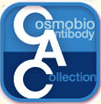 CAC Antibody Collection
CAC Antibody Collection
The antibodies on this page are part of Cosmo Bio's exclusive CAC Collection. For many many thousands of other antibodies from many different makers, use our Search the Store function and our Explore Products drop down menu.
Novel iPS/ES markers / Pluripotency-associated
| Stem cells: Novel iPS/ES markers | |||
| Product name (click for order info) | Cat No (click for datasheet) |
Host | Species specificity |
| Anti Keratan Sulfate (KS/Keratosulfate) lacking oversulfated structures mAb (Clone R-10G) | CAC-RIT-M001 | MS | HU |
| Stem cells: Pluripotency-associated | |||
| Product name (click for order info) | Cat No (click for datasheet) |
Host | Species specificity |
| Anti Developmental Pluripotency-Associated Protein 4 (Dppa4) pAb (Rabbit, Ammonium Sulfate Purified) | CAC-TMD-PB-DP4 | RAB | MS |
| Anti POU Domain, Class 5, Transcription Factor 1 (POU5F1/Oct4) mAb (Clone 1C10) | CAC-CEC-053 | RT | MS |
Novel iPS/ES markers
Adult stem cells have limitations with their potency; unlike embryonic stem cells (ESCs), they are not able to differentiate into cells from all three germ layers. As such, they are deemed multipotent. However, reprogramming allows for the creation of pluripotent cells, induced pluripotent stem cells (iPSCs), from adult cells. These are not adult stem cells, but adult cells (e.g. epithelial cells) reprogrammed to give rise to cells with pluripotent capabilities. Using genetic reprogramming with protein transcription factors, pluripotent stem cells with ESC-like capabilities have been derived. The first demonstration of induced pluripotent stem cells was conducted by Shinya Yamanaka and his colleagues at Kyoto University. They used the transcription factors Oct3/4, Sox2, c-Myc, and Klf4 to reprogram mouse fibroblast cells into pluripotent cells. Subsequent work used these factors to induce pluripotency in human fibroblast cells. Junying Yu, James Thomson, and their colleagues at the University of Wisconsin–Madison used a different set of factors, Oct4, Sox2, Nanog and Lin28, and carried out their experiments using cells from human foreskin. However, they were able to replicate Yamanaka's finding that inducing pluripotency in human cells was possible.
Induced pluripotent stem cells differ from embryonic stem cells. They share many similar properties, such as pluripotency and differentiation potential, the expression of pluripotency genes, epigenetic patterns, embryoid body and teratoma formation, and viable chimera formation, but there are many differences within these properties. The chromatin of iPSCs appears to be more "closed" or methylated than that of ESCs. Similarly, the gene expression pattern between ESCs and iPSCs, or even iPSCs sourced from different origins. There are thus questions about the "completeness" of reprogramming and the somatic memory of induced pluripotent stem cells. Despite this, inducing adult cells to be pluripotent appears to be viable.
Furthermore, induced pluripotent stem cells provide several therapeutic advantages. Like ESCs, they are pluripotent. They thus have great differentiation potential; theoretically, they could produce any cell within the human body (if reprogramming to pluripotency was "complete"). Moreover, unlike ESCs, they potentially could allow doctors to create a pluripotent stem cell line for each individual patient. Frozen blood samples can be used as a valuable source of induced pluripotent stem cells. Patient specific stem cells allow for the screening for side effects before drug treatment, as well as the reduced risk of transplantation rejection. Despite their current limited use therapeutically, iPSCs hold create potential for future use in medical treatment and research. [Adapted from Wikipedia: https://en.wikipedia.org/w/index.php?title=Stem_cell&oldid=895290411]
| Product name | Anti Keratan Sulfate (KS/Keratosulfate) lacking oversulfated structures mAb (Clone R-10G) |
| Cat No | CAC-RIT-M001 |
| Description | Monoclonal antibody R-10G recognizes keratan sulfate lacking oversulfated structures in oligosaccharide segments of keratan sulfate glycosaminoglycan chains on human induced pluripotent stem (hiPS) cells. Digestion with Keratanase II, Keratanase or Endo-beta-galactosidase removes these epitopes from keratan sulfate proteoglycans. Unlike commercially available keratan sulfate-recognizing antibodies 5D4 and BCD4, R-10G recognizes keratan sulfate with a low degree of sulfation. The antigenic polypeptide portion has been identified as podocalyxin. Importantly, R-10G antibody binds to human iPS cells and human ES cells, but only at very low levels to human embryonal carcinoma (EC) cells. Unlike widely used human pluripotent stem cell marker antibodies TRA-1-60 (IgM) and TRA-1-81 (IgM), R-10G (IgG1) binds only weakly to EC cells. Therefore, R-10G is useful for quality control of human iPS and ES cells. References: 1) Kawabe K, et al, A novel antibody for human-induced pluripotent stem cells and embryonic stem cells recognizes a type of keratan sulfate lacking oversulfated structures. Glycobiology. 2013 Mar;23(3):322-36. PubMed: 23154990 2) Schopperle WM, et al, The TRA-1-60 and TRA-1-81 human pluripotent stem cell markers are expressed on podocalyxin in embryonal carcinoma. Stem Cells. 2007 Mar;25(3):723-30. PMID: 17124010 |
| Host | Mouse |
| Species specificity | HU |
| Figure 1 | 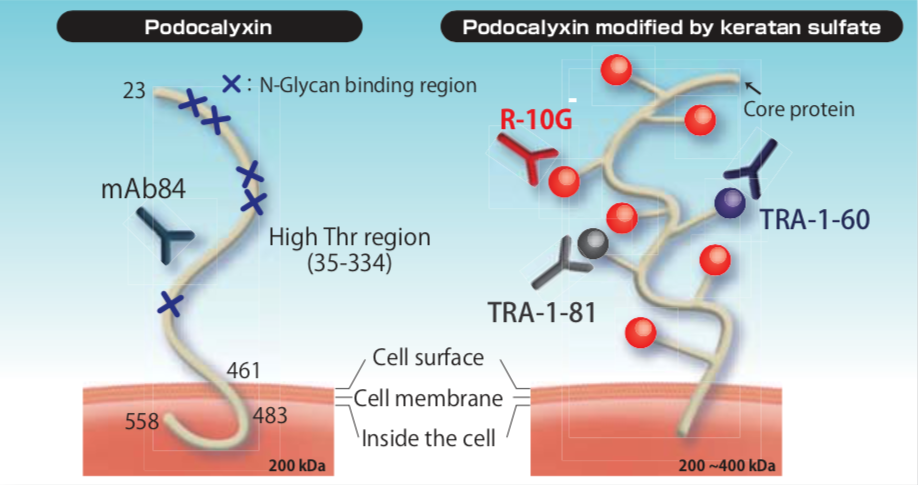 |
| Pluripotent cell epitopes on the Podocalyxin molecular structure. | |
| Figure 2 | 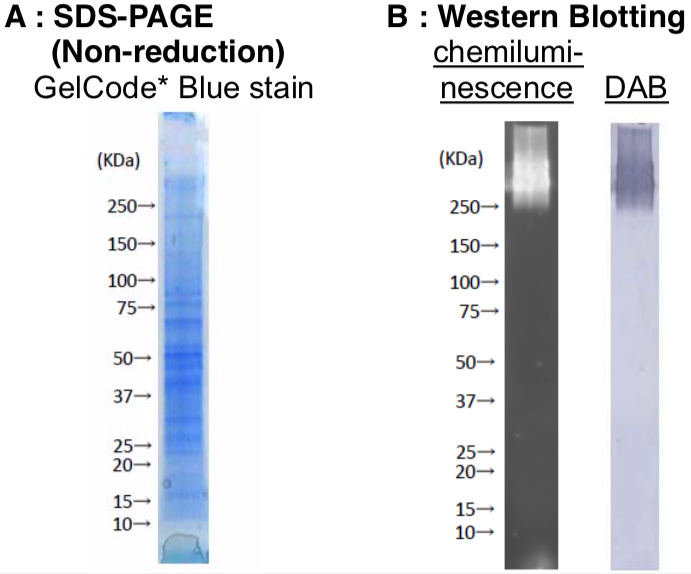 |
| Screening of R-10G mAb by western blotting.Tic cell lysates in complete RIPA buffer were resolved by SDS-PAGE on a 4-15% gradient gel under nonreducing conditions, followed by immunoblot detection with R-10G. | |
| Figure 3 |  |
| Localization of R-10G and TRA-1-81 epitopes on cultured Tic (hiPS) cells visualized by laser confocal microscopy. Tic cells cultured on Millicell® EZ slides were double-stained with R-10G and Alexa Fluor® 488-conjugated secondary (anti-mouse IgG1) antibody, followed by TRA-1-81 and Alexa Fluor® 555-conjugated secondary (anti-mouse IgM) antibody. Cells were observed at two different magnifications: ×100 (upper panel) and ×400 (lower panel). (I) Nomarski imaging. (II) Nuclear counterstaining with TO-PRO®-3. (III) Antigens for R-10G (green). (IV) Antigens for TRA-1-81 (conventional hiPS marker antibody) (red). (V) Merged image of (III) and (IV). (VI) Close-up view of V (×400). GelCode® is a registered trademarks of Thermo Fisher Scientific Co. and the subsidiary company's trademark. Millicell® is a registered trademarks of Merck Millipore (Merck KGaA). Alexa Fluor® and TO-PRO®a registered trademarks of Life Technologies Corporation. Ritsumeikan University Glycoengineering Research Center Toshiya Kawashima |
|
| Table |  |
| Comparison of R-10G antibody and existing iPS/ES marker antibody. iPS cells, induced pluripotent stem cells; ES cells, embryonic stem cells; EC cells, embryonal carcinoma cells. TRA-1-60, TRA-1-81 are from: Schopperle Et Al , WM , Stem Cells 2007 Mar; 25 (3): 723-30. |
|
| Pluripotency-associated |
|
| Pluripotency is maintained through a complex network of signaling pathways that interact with transcription factors including octamer binding protein 4, SRY-box 2, and Nanog, chromatin modifying complexes, microRNAs, and the DNA structure itself to preserve the undifferentiated, self-renewing state. Whereas the signaling requirements for the maintenance of stem cells can vary by species of origin, state of the stem cells, and culturing conditions, the core transcriptional circuity activated and maintained by these pathways is highly conserved. The self-sustaining nature of the pluripotency network is evident in the finding that somatic cells can be reprogrammed to a pluripotent state through the transient introduction of a small group of factors, which serve to reestablish the stem cell signaling and transcriptional network. Growing understanding of the molecular circuitry of pluripotency has major implications for the field's view of developmental biology and disease pathogenesis and is important for the evolving field of regenerative medicine. [from: Rachel H. Klein and Paul S. Knoepfler. “The Molecular Circuitry Underlying Pluripotency in Embryonic and Induced Pluripotent Stem Cells.” Principles of Regenerative Medicine 3rd Edition, edited by Anthony Atala, Robert Lanza, Antonios G. Mikos and Robert Nerem, Academic Press, 2019, pp. 49-63.] | |
| Product name | Anti Developmental Pluripotency-Associated Protein 4 (Dppa4) pAb (Rabbit, Ammonium Sulfate Purified) |
| Cat No | CAC-TMD-PB-DP4 |
| Description | DPPA4 (developmental pluripotency associated 4) is a highly expressed gene in early embryos and ES cells. DPPA4 binds to transcriptionally active chromatin and suppresses the differentiation of ES cells into primitive ectoderm (future endoderm). Source: Professor Hirofumi Teraoka, Department of Pathology and Biochemistry, Research Institute for Intractable Diseases, Tokyo Medical and Dental University. References: Masaki H, Nishida T, Kitajima S, Asahina K, and Teraoka H.: J. Biol. Chem. 282, 33034-33042 (2007). |
| Host | Rabbit |
| Species specificity | MS |
| Figure 1 |  |
| Western blot analysis of DPPA4 in soluble and insoluble chromatin fractions. | |
| Figure 2 | 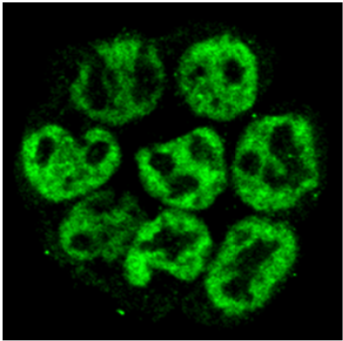 |
| Confocal image of ES cells immunostained with anti-DPPA4 antibody. | |
| Product name | Anti POU Domain, Class 5, Transcription Factor 1 (POU5F1/Oct4) mAb (Clone 1C10) |
| Cat No | CAC-CE-052A |
| Description | Oct4/Pou5f1 is a member of POU transcription factor family, which possess POU domain. This transcription factor forms a trimeric complex with SOX2 on DNA and controls the expression of a number of genes involved in embryonic development such as YES1, FGF4, UTF1 and ZFP206. Oct4/Pou5f1 is critical for early embryogenesis and for embryonic stem cell pluripotency. References: Sterneckert, J. et al. (2012) Oct4 and More: The Reprogramming Expressway. Stem Cells. 30(1):15-21. |
| Host | RT |
| Species specificity | MS |
| Figure 1 | 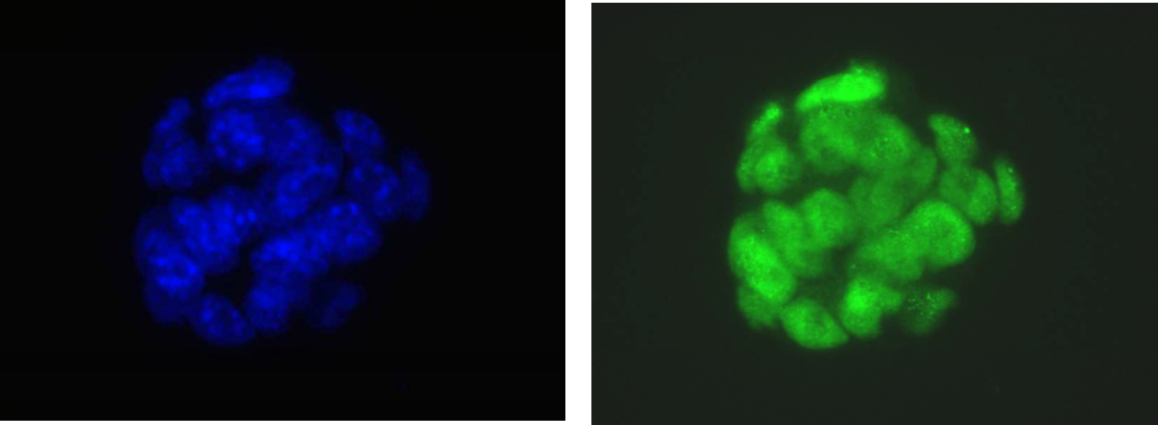 |
| Immunocytochemistry/Immunofluorescence analysis of Oct4/Pou5f1 antibody (1C10) on mouse ES cells. DAPI (blue), Oct4 (green) | |
| Figure 2 | |
| Immunoblot analysis of Oct4/Pou5f1 antibody (1C10) on mouse ES total extracts. | |
